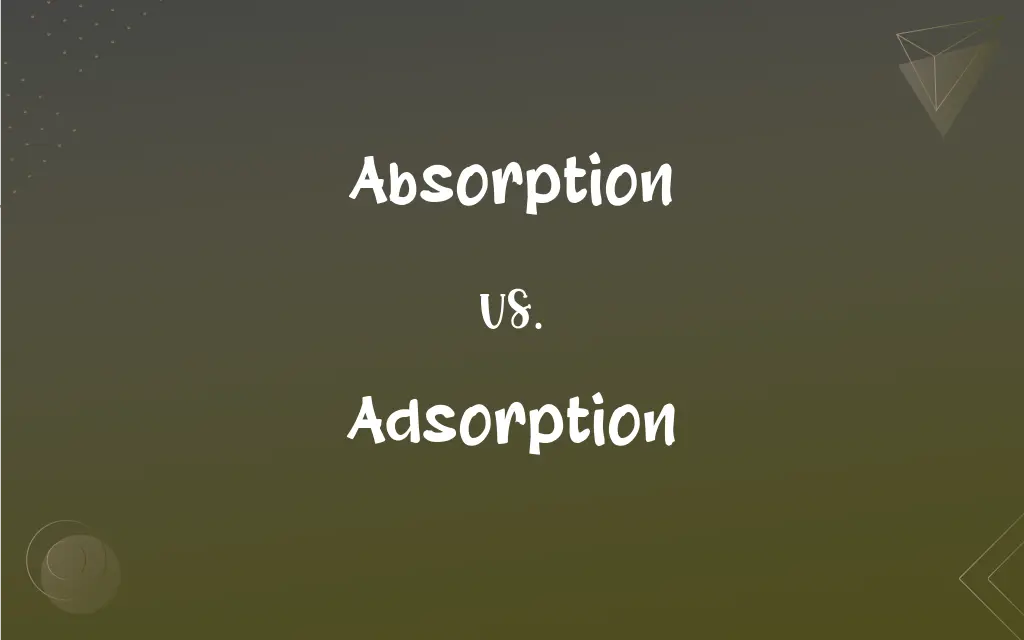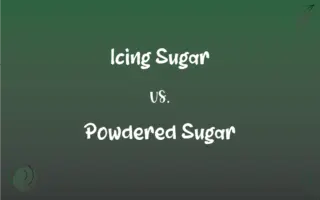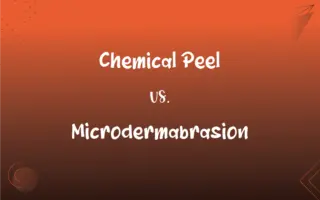Absorption vs. Adsorption: What's the Difference?
Edited by Aimie Carlson || By Harlon Moss || Updated on October 12, 2023
Absorption involves a substance uniformly penetrating into the volume of another; adsorption concerns a substance accumulating on the surface of another. Both are different physical-chemical processes.

Key Differences
Absorption refers to the process in which a substance permeates or is assimilated into the volume of another substance, essentially becoming part of the latter. It can occur in various phases - a liquid absorbing a gas, a solid absorbing a liquid, and so forth. On the other hand, adsorption takes place when atoms, ions, or molecules from a substance (gas, liquid, or dissolved solid) adhere to the surface of an adsorbent substance. Thus, while absorption involves full permeation, adsorption is focused on surface accumulation.
In absorption, one can observe the complete assimilation or permeation of one substance into another’s volume, leading to a uniform mixture in many instances. Think about how a sponge absorbs water; the water is taken up into the volume of the sponge, saturating it. Adsorption differs in that it involves molecules adhering or binding to a surface rather than being incorporated into the volume of the material. An example of adsorption would be when gas molecules adhere to the surface of a solid during gas mask filtration.
Looking at absorption, it's crucial to note that this process can change the concentration of the absorbing material and can be affected by factors such as temperature and pressure. In contrast, adsorption, while also concentration-dependent, primarily impacts only the surface layers of the adsorbent material, not its entire volume. The molecules or atoms are drawn and held to the surface, often due to van der Waals forces or chemical bonds, and can form a film over the adsorbent.
In terms of applications, absorption is widely used in various sectors, including in chemical processes where gases are removed from solvent materials, as seen in certain air purification systems. Adsorption finds its applications in diverse areas like chromatography for separating mixtures, in purifying gases, and in certain wastewater treatment processes where pollutants adhere to solid materials.
The phenomenon of absorption could potentially result in changes in properties such as color, density, or even volume of the absorbing material, given that it involves the uniform incorporation of the absorbed substance. Conversely, adsorption, being a surface phenomenon, doesn’t generally alter the bulk properties of the adsorbent but may change its surface properties, like creating a different texture or appearance on the surface due to the adsorbed molecules.
ADVERTISEMENT
Comparison Chart
Process
Involves uniform penetration into volume
Involves accumulation on the surface
Depth of Interaction
Throughout the material
Primarily on the surface
Change in Properties
Can change bulk properties
Affects surface properties
Applications
E.g., in chemical processes to remove gases
E.g., in gas purification and chromatography
Kinetics
Often a slower process
Typically a faster process
ADVERTISEMENT
Absorption and Adsorption Definitions
Absorption
Absorption is the process of one material permeating into the volume of another.
The sponge demonstrated rapid absorption of the spilled water.
Adsorption
In chemistry, adsorption refers to the adhesion of atoms, ions, or molecules from a gas, liquid, or dissolved solid to a surface.
The adsorption of gases on solid surfaces is utilized in air purifiers.
Absorption
In physics, absorption can refer to the uptake of light or energy by a substance.
The dark material increased heat absorption due to its color.
Adsorption
In environmental science, adsorption can depict the adherence of pollutants to a surface, aiding in detoxification or purification efforts.
The adsorption properties of certain minerals can mitigate the presence of toxins in wastewater.
Absorption
Absorption, in biology, refers to the uptake of nutrients or substances into cells or tissues.
The small intestine plays a critical role in the absorption of nutrients.
Adsorption
In physical chemistry, adsorption might entail the accumulation of a substance at the boundary of a solid or liquid phase.
Upon adsorption, a visible layer of material was evident on the surface of the metal.
Absorption
In chemistry, absorption can involve a reactant being taken into the bulk of a solvent.
The absorption of the gas into the liquid created a new solution.
Adsorption
Adsorption is the process where molecules adhere to the surface of a material.
The adsorption of dye molecules on activated charcoal helps in water purification.
Absorption
Absorption, in acoustics, refers to the taking up of sound energy by a material.
The thick curtains aided in the absorption of sound, reducing the echo in the room.
Adsorption
Adsorption can indicate a surface-based process utilized in separation techniques, such as chromatography.
Gas chromatography often involves the adsorption of gaseous compounds onto a stationary phase.
Absorption
The act or process of absorbing or the condition of being absorbed.
Adsorption
The accumulation of gases, liquids, or solutes on the surface of a solid or liquid.
Absorption
A state of mental concentration.
Adsorption
The adhesion of a liquid or gas on the surface of a solid material, forming a thin film on the surface.
Adsorption
The process by which molecules of a substance form a thin film on the surface of a solid. Distinguished from absorption, in which the foreign substance penetrates the body of the absorbing material.
Adsorption
The accumulation of molecules of a gas to form a thin film on the surface of a solid
FAQs
Are absorption and adsorption the same?
No, absorption involves permeating into volume, while adsorption involves adhering to surfaces.
How does temperature affect adsorption?
Typically, as temperature increases, physical adsorption decreases and chemical adsorption may increase, depending on the system.
Is absorption a surface phenomenon?
No, absorption involves a substance permeating throughout the volume of another.
Can adsorption occur in liquids?
Yes, adsorption can involve particles adhering to the surface of a liquid or solid.
Are adsorption processes always exothermic?
Most physical adsorption processes are exothermic, but specific scenarios might vary.
Can absorption also involve gases?
Yes, absorption can involve gases being taken up by liquids or solids.
Can absorption result in a phase change?
Yes, sometimes absorption can cause a phase change, depending on the substances involved.
Is adsorption only applicable in chemistry?
No, adsorption is utilized in various fields like environmental science, engineering, and biology.
Is absorption relevant in light phenomena?
Yes, absorption can refer to light energy being taken up by a material.
How does pressure impact absorption?
In many cases, increasing pressure increases the rate and extent of absorption.
Is absorption involved in human digestion?
Yes, absorption in the small intestine allows nutrients to enter the bloodstream.
Can adsorption alter surface properties?
Yes, adsorption can change surface properties like appearance and texture.
Does absorption always involve fluids?
No, absorption can involve various phases (solid, liquid, gas).
Can adsorption purify air and liquids?
Yes, adsorption is commonly used in air purifiers and water purification systems.
Does the entire substance participate in absorption?
Yes, in absorption, the substance is taken up into the entire volume of the absorber.
What is a common adsorbent material?
Activated carbon is a widely used adsorbent due to its porous structure.
Is the rate of absorption always constant?
No, the absorption rate can vary with concentration, temperature, and other factors.
Can adsorption be utilized in medical applications?
Yes, adsorption is utilized in various medical applications, like in certain detoxification procedures.
Is it possible to regenerate adsorbents?
Yes, many adsorbents can be regenerated through processes like heating or pressure reduction.
Does adsorption always lead to visible changes?
Not always; while some adsorption is visible, other instances might be microscale and not visibly noticeable.
About Author
Written by
Harlon MossHarlon is a seasoned quality moderator and accomplished content writer for Difference Wiki. An alumnus of the prestigious University of California, he earned his degree in Computer Science. Leveraging his academic background, Harlon brings a meticulous and informed perspective to his work, ensuring content accuracy and excellence.
Edited by
Aimie CarlsonAimie Carlson, holding a master's degree in English literature, is a fervent English language enthusiast. She lends her writing talents to Difference Wiki, a prominent website that specializes in comparisons, offering readers insightful analyses that both captivate and inform.






































































